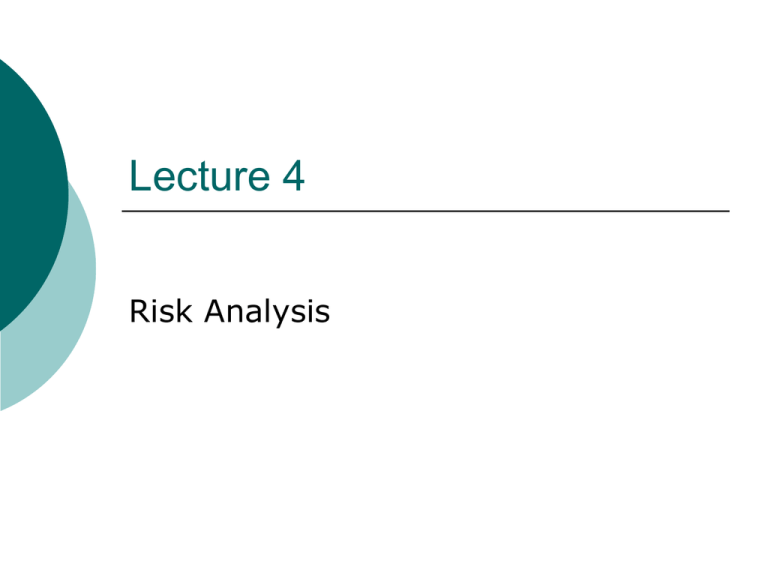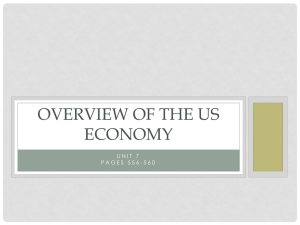Lecture 4 Risk Analysis
advertisement

Lecture 4 Risk Analysis Invest or not Invest in Developing Countries? YES! Growing economies; Increasing investment opportunities; High revenues. NO! Default risk; Volatility and Instability. Which Problems in Investment Decision? Too complex to measure: Many variables (both qualitative and quantitative); Not common pattern across countries. Few and unreliable data; Unstable patterns and unpredictable change; = UNSURE OUTCOME! = RISK! Country Risk Analysis: Definition Businessmen and bankers must make their choices based on their analysis, taking into consideration how today’s choices are likely to affect their companies/investment in the future. This implies a certain amount of risk. Probability of occurrence of negative events that will change the profitability of a given investment. All the additional risks induced by doing business abroad, as opposed to domestic transitions. Risk & Probability RISK is a hazard or chance of loss; The bigger the chance of loss, the more risky a particular course of action is; Chance of loss = probability of loss; PROBABILITY: measure of the degree of belief that an event will occur: Frequency definition: P(A)=r/R Subjective definition. Probability (1) Probability (2) The Probability Distribution: ? Invest or not in Sovereign bonds in Argentina: Possible consequences/events: The country would default : The country would not default: Pr(A) = 0.4 Pr(B) = 0.6 Σ 1 Expected Value of the Profit/Outcome: To each possible event corresponds a loss/gain: The country would default = -600,000$ The country would NOT default = + 1,000,000$ EV = 0.6*(1,000,000) + 0.4*(-600,000) = 360,000 EV = Pr(B)*(Vb) + Pr(A)*(Va) How can we make a decision? The Decision Tree A situation involving decision making under condition of risk has the following characteristics: 1. 2. Make a choice (or a series of choice) among alternative courses of action (decision fork); The choice leads to some consequences that depend on some unpredictable events as well as on the choice itself (chance fork). Example: Shell Oil corporation DECISION: do we drill a well in Zambia? To make the decision, the firm collects info about: - Cost of drilling; Price of oil; Geologists’ report about the likelihood af striking oil. Example: Shell Oil corporation Event Probability Outcome No oil .60 - 90,000$ 10,000 barrels .15 + 100,000$ 20,000 barrels .15 + 300,000$ 30,000 barrels .10 + 500,000$ The Attitudes Toward Risk (1) Invest in Russian bonds: Event Pr Profit ($) No Default 0.5 4,100 Default 0.5 -60$ OR invest in US bond: sure profit = 2,000$ Which investment do you prefer? It depends on your attitude to risk! The Attitudes Toward Risk (2) Although one can expect that utility increases with monetary gain, the shape of the utility function can vary greatly, depending on the preferences of the decision maker: CONCAVE: risk averters; CONVEX: risk lover; LINEAR: risk neutral. Measures of Risk Risk is not easy to measure; BUT the riskiness of a decision is directly related to the dispersion of the possible profits resulting from the decision; Statistical Measure = Standard Deviation: N i 1 E ( ) Pi 2 i Larger S.D. = Greater likelihood that the profitability would depart greatly from the expected value! = Larger amount of risk! Adjusting the Valuation Model for Risk Adjusting the Expected Cash Flows for the country risk: n ut CFt NPV t ( 1 i ) t 0 With u = risk probability; 0<u<1. Adjusting the Discount Rate: n CFt NPV t ( 1 i k ) t 0 With k = risk premium For Next Lesson! http://www.trading-safely.com/ Choose a country; Ignore the sector option! Print and bring to the lesson all the material about the country available in the web-page. References Bouchet, Clark and Groslambert (2003): “Country Risk Assessment”, Wiley finance (chapter 2). Mansfield, E. (1993): “Managerial Economics. Theory, Application, and Cases” Norton (Chapter 13).



